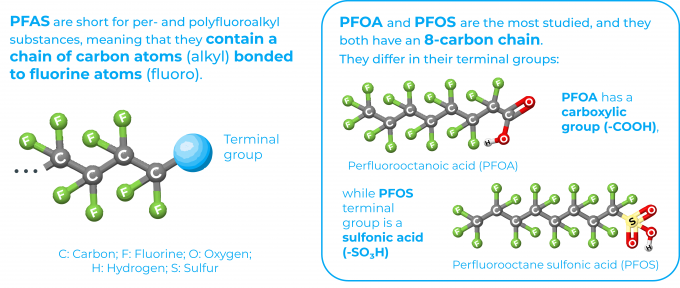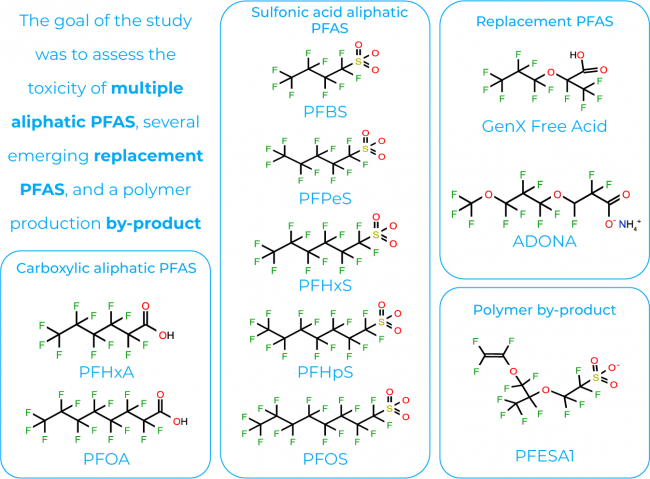In this series of articles, we review some of the key scientific publications of 2020 which included zebrafish in their studies. This second review will cover an article published in Environmental Health Perspective on April 9th 2020: Evaluation of Developmental Toxicity, Developmental Neurotoxicity, and Tissue Dose in Zebrafish Exposed to GenX and Other PFAS1.
In this article, the authors have studied the toxicology of different PFAS, short for poly and perfluoroalkyl substances, which are substances widely present in our daily life.
PFAS and concerns about their use
Probably it is the first time you are reading about PFAS, short for poly and perfluoroalkyl substances. Probably you did not even know that they existed, but most likely you have been in contact with any of these compounds in the last week. This class of compounds are found in a wide range of consumer products2 that we use daily such as cookware, pizza boxes and water-repellent textiles.

Some features that have made PFAS so widespread relate to their flame-retardant, water-resistant, and oil-repellent properties2. Besides, they are thermally and chemically stable, which makes them resistant to the most common processes of degradation2. As a result, they are normally found in the environment: in wildlife, drinking water or even in humans2.
After exposure, certain PFAS are absorbed by the human body, where they can accumulate for long periods of time. Of the relatively few well-studied PFAS, PFOA and PFOS are considered moderately to highly toxic2,3. Studies indicate that PFOA and PFOS can cause reproductive and developmental, liver and kidney, and immunological effects in laboratory animals. Among exposed populations, the most consistent findings are increased cholesterol levels, and there are limited observations related to low infant birth weights, effects on the immune system, cancer (for PFOA), and thyroid hormone disruption (for PFOS).

In the early 2000s, there was a voluntary phaseout of PFOA and PFOS by industry. Despite an indicative decrease on human exposures to these compounds, they are still found in the environment and in human subjects2. To address toxicity concerns, PFOA and PFOS have been replaced with compounds such as PFBS, GenX o ADONA.
Replacement PFAS are consequently increasingly detected in the environment: in wildlife, but also in drinking water3. Thus, there is a growing concern over the safety of PFBS, GenX, ADONA and other replacement PFAS which has unsurprisingly led to a greater demand for toxicity data.
Grouping PFAS based on shared toxicity phenotypes
The OECD has identified 4,730 PFAS structures and, only in the United States, there are 602 PFAS in active commercial use4. Most of these compounds lack adequate toxicity data. To confront this gap in our understanding of PFAS toxicity, the Zurich Statement on PFAS established a strategy to assess and manage highly persistent chemicals such as PFAS.
One of the callings of the Zurich Statement was to study PFAS by grouping them rather than cataloguing the effects of individual chemicals5. This way, it seems promising to group chemicals by their toxicological activities and, perhaps in doing so, identify structural features that cause the same toxicity phenotypes in vivo.
To do so, the authors of today’s reviewed article selected different PFAS, with different chemical structures, and evaluated the toxicity of these compounds in zebrafish embryos.

Zebrafish as models for toxicology testing
Zebrafish are a widely used in vivo model for toxicity testing. Compared to traditional mammalian toxicity tests, zebrafish assays are less costly and much faster6. They allow for example to test multiple chemicals and concentrations of chemicals in parallel. Besides, their development is rapid, with organogenesis complete by 3 days post fertilization (3dpf). Therefore, zebrafish developmental toxicity testing can be completed in a matter of days by directly exposing the developing organism to xenobiotics.
On the other hand, zebrafish have some similarities with humans: the zebrafish genome contains orthologs for about 70% of human genes and approximately 86% of their genes are known as human drug targets7.
To evaluate the toxicity of the selected PFAS, the authors of the study carried out two types of assays on zebrafish embryos: developmental toxicity assays (DevTox) and developmental neurotoxicity assays (DNT). Besides, they analysed the level of compounds in the media and the zebrafish bodies to corroborate that the compounds were absorbed by the embryos.

In both assays, zebrafish embryos were exposed daily from 1-5 dpf to different concentrations of the studied PFAS. Then, at 6 dpf the embryos were evaluated, and media and tissue were collected to analyse the level of PFAS. For the DevTox assay zebrafish larvae were evaluated for survival, hatching, swim bladder inflation, and malformations. On the other hand, the DNT assays measured the swimming behaviour.
Emerging PFAS shows negative effects on zebrafish
As previously mentioned, one of the objectives of the study is to group PFAS based on shared toxicity phenotypes. Accordingly, they identify three groups of PFAS toxicity outcomes in zebrafish:
- Failed swim bladder inflation, abnormal flexion of the tail and hyperactivity for PFAS with a carbon chain bigger than four carbons and a sulfonic acid group.
- No developmental toxicity but hyperactivity for PFHxA.
- Neither developmental toxicity nor changes in the swimming behaviour for emerging PFAS, such as GenX, ADONA and another PFAS derivatives.
Besides, although carbon chain length generally increases PFAS potency, this dogma cannot be universally applied to all structurally similar PFAS, as there is an observed exception to this rule: PFPeS (PFAS with five carbon chain length and a sulfonic acid).
Conclusion
Similarities between zebrafish and people are not just based on the percentage of genes we share. Many of our organs are also found in these fishes, and the critical pathways that are required for organ development are highly conserved between humans and zebrafish7.
Although humans do not have a swim bladder, the authors of the study remark that this organ shares functional and structural similarities with the lung8. This is not the first study showing that sulfonic acid alkyl PFAS with at least five carbon atoms can cause developmental lethality and malformations in zebrafish embryos consisting of swim bladder inflexion and abnormal flexion of the tail1. In rodents, prenatal exposure to PFOS led to high levels of lethality in neonatal rodents, and those who died presented noted changes in lung histology9. In humans, epidemiologic evidence has shown that exposure to PFAS during pregnancy can result in decrease lung function on children10.
As interesting as these similarities can be, they are also aware that there is still more work to do to determine the relevance of sim bladder defects for human health risk assessments. Another key point that needs to be further explore is the mechanisms by which PFAS cause locomotor hyperactivity in zebrafish. Finally, future research should test mixtures of different PFAS. PFAS are not presented alone in nature, but as groups of related PFAS. Thus, it is most likely that many could provoke additive or synergistic disruption of signalling pathways.
The zebrafish model seems a promising in vivo model to further uncover the possible toxic effects of these substances and to identify less bioactive groups of PFAS.
References
1. Gaballah, S., et al. (2020) Evaluation of Developmental Toxicity, Developmental Neurotoxicity, and Tissue Dose in zebrafish Exposed to GenX and Other PFAS. Environmental Health Perspectives. https://doi.org/10.1289/EHP5843
2. Lindstrom, A.B., et al. (2011) Polyfluorinated Compounds: Past, Present, and Future. Environmental Science & Technology. https://doi.org/10.1021/es2011622
3. Basic Information on PFAS (EPA). Retrieved April 23, 2021. https://www.epa.gov/pfas/basic-information-pfas#:~:text=Commercial%20household%20products%2C%20including%20stain,bases%20where%20firefighting%20training%20occurs
4. About PFASs – OECD Portal on Per and Poly Fluorinated Chemicals (OECD, 2018). Retrieved April 23, 2021. https://www.oecd.org/chemicalsafety/portal-perfluorinated-chemicals/aboutpfass/
5. Ritscher, A., et al. (2018) Zürich statement on future actions on per- and polyfluoroalkyl substances (PFASs). Environ Health Perspectives. https://doi.org/ 10.1289/EHP4158
6. Hamm, J. T, et al. (2019) Characterizing sources of variability in zebrafish embryo screening protocols, ALTEX – Alternatives to animal experimentation. https://doi.org/10.14573/altex.1804162
7. Zhang, T., Peterson, T. R., (2019). The Zebrafish in Biomedical Research. Academic Preshttps://doi.org/10.1016/B978-0-12-812431-4.00051-8
8. Winata, C.L., et al. (2009)mDevelopment of zebrafish swim bladder: the requirement of Hedgehog signaling in specification and organization of the three tissue layers. Developmental Biology. https://doi.org/10.1016/j.ydbio.2009.04.035.
9. Grasty, R. C, et al. (2005) Effects of prenatal perfluorooctanesulfonate (PFOS) exposure on lung maturation in the perinatal rat. Birth Defects Research Part B Developmental and Reproductive Toxicology. https://doi.org/10.1002/bdrb.20059.
10. Agier, L., et al. (2019) Early-life exposome and lung function in children in Europe: ananalysis of data from the longitudinal population-based HELIX cohort. Lancet Planet Health. https://doi.org/10.1016/S2542-5196(19)30010-5.



